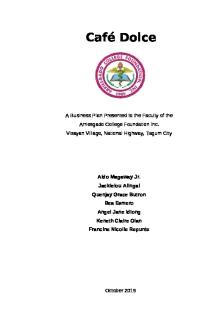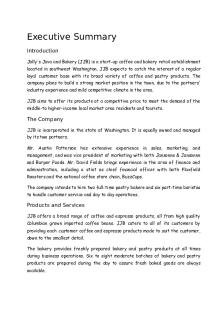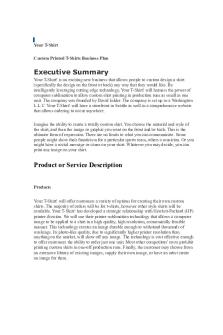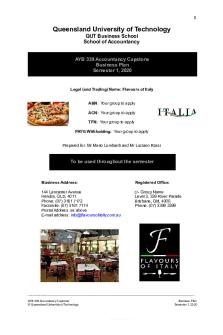Writing A Business PLAN - guide PDF

| Title | Writing A Business PLAN - guide |
|---|---|
| Course | Entrepreneurial Economics And Entrepreneurship |
| Institution | Università Commerciale Luigi Bocconi |
| Pages | 12 |
| File Size | 480.4 KB |
| File Type | |
| Total Downloads | 59 |
| Total Views | 144 |
Summary
guida su come fare il lavoro di entrepreneurship and strategic innovation for the fashion industry....
Description
BUSINESS MODELS Pillars of the business model canvas 1. Client segment: all the people who generate value 2. Value proposition: product or service that creates value for the customers 3. Channel: customers touchpoint and delivery value 4. Customer relationship: type of relationship established with the customers 5. Revenue streams 6. Key resources: structure to create, deliver and capture value. Assets indispensable for the business model 7. Key activities: show what you really need to be able to perform well 8. Key partner: who can help you to leverage your business 9. Cost structure Difference between industrial brands, retailers, online multisided platform - Brands Value proposition: unique product design and brand narratives as the result of datainformed &/or design-driven approach. Go to market strategy: B2B, B2C. the revenue model is the sell in revenue with a wholesale price when the brand has a B2B strategy; sell out revenue with a retail price when B2C. - Retailers Value proposition: retail assortment direct to the final consumer. Go to market strategy: B2C only, sell out revenue and retail price - Multisided platforms Value proposition: create value by enabling interaction between two or more customer groups and reducing searching cost and transaction costs. Go to market strategy: get two or more sides on board and enable interactions between them. Direct interaction between the two sides or is instead entirely controlled by the intermediary. Sell in vs sell out Sell out is a B2C strategy with the aim to sell all the warehouse as soon as possible. Sell in is a B2B strategy address to the reseller. This strategy has the aim to fill the warehouse of the stores. Characteristics of different business models - Luxury brands and conglomerates:
-
Fashion designers: seasonal designer creativity and the brand world.
-
Premium brands: trend and value of the brand mix
-
Mass retailers and fast retailers: convenience, range, fashion trend
Direct to consumer business models
Direct to consumer business model is a strategy adopted by vertical integrated companies which made their appearance in America in 2010. They were born with the mission to have a direct relationship with their customers, cutting out all the middlemen. Their major advantage is to offer high quality product at a very competitive price. They base their relationship on radical transparency and embracing social problem, having as ultimate goal to simplify customer journey.
WRITING A BUSINESS PLAN 1. WHAT IS REQUIRED TO RECOGNIZE OPPORTUNITIES
A business opportunity either solves a real problem for customers, offers significant risk-adjusted profit potential, fits well with the capabilities of the leadership team, is potentially profitable and is amenable to financing. To recognize these opportunities, you must have creative skills and discovery skills: Associating: Connecting seemingly unrelated questions, problems, or ideas Questioning: Asking questions that challenge conventional wisdom and the status quo Observing: Scrutinizing common phenomena, particularly the behavior of customers Networking: Cultivating a network with diverse perspectives, expertise, and experiences Experimenting: Reducing uncertainty by designing focused experiments to test assumptions and “learn by doing” 2. ENTREPRENEURSHIP/ INTRAPRENEURSHIP DEFINITION 3. CHARACTERISTICS OF SUCCESSFUL ENTREPRENEURS ⁃ Academic Definition (Stevenson & Jarillo): Entrepreneurship is the process by which individuals pursue opportunities without regard to resources they currently control ⁃ Venture Capitalist (Fred Wilson): Entrepreneurship is the art of turning an idea into a business. ⁃ Explanation of What Entrepreneurs Do: Entrepreneurs assemble and then integrate all the resources needed, the money, the people, the business model, the strategy to transform an invention or an idea into a viable business ⁃ Intraprenuership is entrepreneurship that happens within a large organization ⁃ Entepreneurers must: have passion for the business, be focused of the product and the customer, have tenacity despite failure and execution intelligence. 4. WHAT IS A BP AND WHY IS IT IMPORTANT Business plan: A business plan is a document that explains a business opportunity, identifies the market to be served, and provides details about the intrapreneurial organization plans to pursue it. It describes the unique qualifications of the management team and explains the resources required for success and provides a forecaster of results are over a reasonable time horizon. 5. WHAT’S THE RELATIONSHIP BETWEEN A BUSINESS MODEL AND A BUSINESS PLAN A business model is an important part, but only of one piece, of a full business plan. It includes the strategic position of the venture and the capabilities and resources required to execute it, and the value proposition to all stakeholders, it helps the onion dip in order to clarify the assumption behind the cash flow forecast. The business plan describes business model assumptions and the data and analytics performed in shaping the opportunity into a story that explain how the entrepreneur has defined a unique strategic position and how it will attract the resources and build the capabilities needed to execute the strategy.
6. DATA SOURCES TO BE USED TO WRITE A BUSINESS PLAN Data should be reliable, consistent, reasonable and realistic. Primary data: - Walk around - Meeting Secondary data: - Interviews - Web - Personal networks - Reports and researches
-
Specialized press
-
Company documents
7. COMMON TYPES OF BUSINESS PLANS Types of business plans: - External stakeholders o Mini–business plans contain a summary of essential components of a new venture’s strategy, its go-to- market and operating plans, and how these plans translate into financial forecasts. o Traditional business plans contain a more detailed discussion of the strategy and the go-to-market and operating plans and provide significant detail on how these plans translate into financial forecasts, including multiple scenario-based stress tests to clarify key areas of uncertainty and risk. - Internal planning purposes o Go-to-market plans describe the unmet needs of early adopter customers; the product, service, or solution that will be developed to address these needs; and the value proposition and benefits that will be delivered. o Operating plans define the key activities and milestones that must be accomplished as founders develop, produce, and deliver the venture’s first offering. 8. KEY ELEMENTS OF THE BUSINESS PLAN 9. IMPORTANCE OF THE TEAM Purposes: ⁃ A solid business plan is essential for any business that seeks outside funding from banks. You can’t get funding without a business plan. ⁃ The actor of writing the plan will force you and your team are to think through all the key elements of your business ⁃ Trusted and experienced outsiders who review your initial plan will help you identify weaknesses, missed opportunities, assumptions and overly optimistic projections ⁃ Fixing the problems on paper will reduce the chances of future failure ⁃ A solid plan can be a blueprint for operating your business in the first one or two years. It will specify target to customers and success factors. ⁃ The financial projections can be used as a budget, actual results that fall short of planned results will prompt you to investigate and take corrective action It is a structured means for a management team to: Address all business issues rigorously and in a disciplined fashion and develop operating and strategic assumptions for all aspects of the business Test these assumptions on an on-going basis Monitor operating strategic business goals and measure how your business meets these objectives on an on-going basis Update and change assumptions and, therefore, operating procedures, as business conditions change Attract investment, corporate partners and/or potential acquirers (external communication) and create consensus and knowledge sharing internally (internal communication) Structure and formats of business plans: A business plan needs to be well organized. It would be wise to tailor your plan format to the likely interests of your readers. Follow the first rule of every form of writing, “know your audience”. The goal is to give readers the information they needed to make a decision.
It should be organized in sections: ⁃ Contents: also called a table of contents, makes it easy for readers to see what the plan has to offer and where it can be located ⁃ Executive Summary: short section of two or three pages, most important part of the document in terms of selling your plan to financial backers. It is a snapshot off the entire plan, that explains your business to an intelligent reader. ⁃ Opportunity: lucrative opportunity, use this section to describe it - the market factors driving it, the current size, its projected size in the years ahead-. Get the readers to see and appreciate the business opportunity you have identified. Highlight the economics underlying the opportunity and the factors that will drive its success such as market penetration, product innovation and so on. No data bump. ⁃ Company, products and strategy: describe the company, explain how it is organized the and state the essential purpose. ⁃ Goals: Include a subsection about the goals of the company and its business strategy, investors will want to know how you plan to grow. ⁃ Strategy: Discussion of the company strategy, which is about differentiation and competitive advantage. What is different about your company’s approach to the marketplace. Is the differentiation in the product/service or in your approach to customers? What makes your product different in the eyes of the customer call mom how will that difference translated into our competitive advantage. ⁃ Ownership: Who are the current owners, what percentage do they control, how is ownership evidenced, which owners are involved in the day-to-day workings and so on. ⁃ Management team: investors are keen to know about the people behind a business, whom they see as key assets, specifically what experience or qualifications do they bring to the enterprise. Most plans use an organized chart to indicate the reporting relationship among key personnel. Appropriate place to identify the board of directors. ⁃ Marketing plan: Best assurance that that a solid customer connection will be made, the plan should be clear about all aspects of marketing: ⁃ Identification of customers ⁃ Number of potential customers and the sale revenues ⁃ Requirements of various segments ⁃ Importance of purchase convenience, rapid delivery, product customization and so on ⁃ Ways to effectively access each segment ⁃ Sales and promotion approaches ⁃ Purchase’s analysis ⁃ Customer price sensitivity ⁃ Cost of acquiring and retaining customers ⁃ Strengths and weaknesses of competitors ⁃ Operating plan: what supplier relationships do you have, how much inventory will be required, are you a manufacturer, which day today operating chores will be handled internally and which be outsourced. ⁃ Financial plan: set of financial financial statements ⁃ Balance sheet: what the company owns, its assets, and how those assets have been financed as of a particular date ⁃ Income statement: it reveals the company revenues them, what is the spent to gain those revenues and the interest and taxes it paid over a period ⁃ Cash flow statement: it tells the readers the sources and the uses of cash during the same period.
Use the space for key data from those statements, key among these data are your sales and expense projections described earlier in the book up as a pro forma income statement. ⁃ Appendix ⁃ Scenarios Key factors in the business plans: ⁃ As you develop your business plan always keep the interest of your readers in mind, put yourself in their place, your audience is looking for a convincing evidence that you have found a real business opportunity with substantial growth possibilities. ⁃ Keep the audience for most in your mind as you develop your business plan ⁃ Tell the readers in a compelling way everything they need to know to make a decision ⁃ Although the principal reason for writing a business plan is to obtain funding, the activity of writing it will force the management team to think through all key elements of the business ⁃ The executive summary should explain the opportunity, tell why it is timely, show how your company plans to pursue it, describe the expected results, provide a thumbnail sketch of the company. ⁃ The plan should the state of the goals are and explain how investors will cash out eventually ⁃ Pay attention to style, use as few words as necessary to get your point across, avoid long sentences, make your document easy to skim by using headings and numbered bullet lists to break up blocks of text. FINANCIAL CONCEPT: DEFINITION AND ELEMENTS 10. Financial concept: Essential documents of business, its Goal is to answer these questions: What does your company own, and what does it owe to others? What are its sources of revenue, and how has it spent its money? How much profit has it made? What is the state of your company’s financial health? It should clarify for the next 3 years (and at least 1 year beyond breakeven point), what are the projections for Income statement (includes detailed revenue source as described in the business model) Cash flow statement Company valuation, utilizing discounted cash flow analysis or revenue multiples Balance sheet Balance Sheet: A way of summarizing their financial positions at a given point in time, usually at the end of the month, the quarter, or the fiscal year. In effect, the balance sheet describes the assets controlled by the business and shows how those assets are financed—with the funds of creditors (liabilities), with the capital of the owners, or with both. A balance sheet reflects the following basic accounting equation: Assets = Liabilities + Owners’ Equity Assets: the balance sheet begins by listing the assets most easily converted to cash: cash on hand and marketable securities, receiv- ables, and inventory. These are called current assets. Generally, current assets are those that can be converted into cash within one year.
Next, the balance sheet tallies other assets that are tougher to convert to cash—for example, buildings and equipment. These are called plant assets or, more commonly, fixed assets (because it is hard to change them into cash). Income statement: The income statement indicates the results of operations over a specified period. It indicates cumulative business results within a defined time frame. It tells you whether the company is making a profit—that is, whether it has positive or negative net income (net earnings). This is why the income statement is often referred to as the profit-and-loss statement, or P&L. It shows a company’s profitability at the end of a particular time It also tells you how much money the company spent to make that profit, from which you can determine the company’s profit margin. We can represent the contents of the income statement with a simple equation: Revenues – Expenses = Net Income (or Net Loss) Cash flow statement: The cash flow statement is the least used and understood. This statement details the reasons that the amount of cash (and cash equivalents) changed during the accounting period. More specifically, it reflects all changes in cash as affected by operating activities, investments, and financing activities. It tells how much cash was on hand at the beginning of the period and how much was on hand at the end. It then describes how the company acquired and spent cash in a particular period. The uses of cash are recorded as negative figures, and sources of cash are recorded as positive figures.
STATE OF FASHION – DEEPER PARTNERSHIP Intro: By exposing the vulnerability of procurement partners, the weakness of contracts and the risks of a concentrated supplier footprint, the crisis accelerated many of the changes that companies were already making to rebalance their supply chain. To mitigate future ruptures, fashion players should move away from transactional relationships in favor of deeper partnerships that bring greater agility and accountability. Issue: The buying community has always been taking the supply chain for granted and creating long-term collateral damage. For years, there have been calls for closer partnerships between brands and suppliers. However, progress has been frustratingly slow. Now, change is finally afoot: - A growing number of executives recognized that nurturing closer relationships is one way to progress while helping to meet their sustainability obligations and support the fashion industry’s transformation to a more flexible demand-focused supply chain. - There’s the need to collaborate and cooperate on the components of finished goods in order to create flexibility, which in turn creates value that can be shared among the partners. - Pandemic:
o during the pandemic, brands were jolted into the realization that their supply chains need to be more resilient. o As the pandemic spread around the globe, supply chains became stretched, leading larger-scale suppliers and sourcing agents with multicountry footprints to gain an advantage. o Cancellations, delayed or reduced payments and contract renegotiations put a spotlight on the continuing power imbalance in the value chain. o Many brands initially reacted slowly to the impact on suppliers and workers of cancellations and payment delays, with many claiming contracts were invalidated by force majeure; the industry response became more nuanced as 2020 progressed. There’s a need for more collective, industry-wide agreements between employers, workers, unions and governments. Expectations: The voice of suppliers is getting louder reaching consumers globally. Many suppliers are demanding a relationship based on mutual respect, fairer treatment, a reasonable share of value and better adherence to contracts. It’s expected to see more suppliers put their buyers’ financials, payment histories and purchasing behaviors under intense scrutiny. However, for now most suppliers concede that brands and retailers continue to have the upper hand. We expect fashion brands will seek to more permanently diversify their geographic sourcing footprint, as well as support priority suppliers with longer-term volume commitments and work more closely with them to align on strategy. A growing number of suppliers are taking measures to compel brands to honor contracts as well as questioning payment terms and the financial risks suppliers are asked to take. First steps towards a closer partnership: - Some brands are responding (ex: H&M) and also governments are moving in that direction too, as more lawmakers around the globe look to move fashion companies away from voluntary initiatives toward taking legal responsibility for their supply chains. ⁃ As brands reinvent their supply chain relationships, they are also likely to take the opportunity to make positive moves on sustainability and human rights. ⁃ Analysis by the Global Fashion Agenda shows that fashion can only play its role with a reduction in excess stock by infusing flexibility in the supply chain in close collaboration with workers. ⁃ They are also partnering with suppliers across tiers, as the production and raw material stages are often the biggest emissions-savings levers. Advantages and solutions: - build better social protection systems in countries where there’s a lot of production - hyper-acceleration on several fronts: from sales volatility and overstock to online market share and sustainability demands by both consumers and investors. - rising pressure on fashion companies to speed up the transformation of purchasing practices and sourcing relationships. - Brands need to cater to a less predictable, multi-channel environment enabling them to source smaller batches and react faster to in-season trends.
-
-
-
-
-
-
-
Strategic suppliers with longer-term relationships will also ...
Similar Free PDFs

Writing A Business PLAN - guide
- 12 Pages

A bakery business plan
- 26 Pages

CUE- Business-PLAN - Business plan
- 10 Pages

Business-Plan - Business plan Enc
- 48 Pages

Example of a Business Plan
- 15 Pages

A business plan for Kopinoy
- 118 Pages

How to plan a business
- 14 Pages

Business Plan
- 26 Pages

Business PLAN
- 3 Pages

Business PLAN
- 21 Pages

Business PLAN
- 10 Pages

BUSINESS PLAN
- 24 Pages

Business Report Writing Skills
- 78 Pages

Business Plan
- 28 Pages
Popular Institutions
- Tinajero National High School - Annex
- Politeknik Caltex Riau
- Yokohama City University
- SGT University
- University of Al-Qadisiyah
- Divine Word College of Vigan
- Techniek College Rotterdam
- Universidade de Santiago
- Universiti Teknologi MARA Cawangan Johor Kampus Pasir Gudang
- Poltekkes Kemenkes Yogyakarta
- Baguio City National High School
- Colegio san marcos
- preparatoria uno
- Centro de Bachillerato Tecnológico Industrial y de Servicios No. 107
- Dalian Maritime University
- Quang Trung Secondary School
- Colegio Tecnológico en Informática
- Corporación Regional de Educación Superior
- Grupo CEDVA
- Dar Al Uloom University
- Centro de Estudios Preuniversitarios de la Universidad Nacional de Ingeniería
- 上智大学
- Aakash International School, Nuna Majara
- San Felipe Neri Catholic School
- Kang Chiao International School - New Taipei City
- Misamis Occidental National High School
- Institución Educativa Escuela Normal Juan Ladrilleros
- Kolehiyo ng Pantukan
- Batanes State College
- Instituto Continental
- Sekolah Menengah Kejuruan Kesehatan Kaltara (Tarakan)
- Colegio de La Inmaculada Concepcion - Cebu

